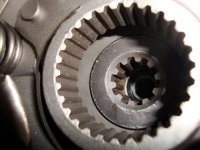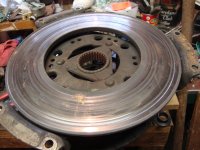rdgemmill
New member
Hi everyone,
I am a new poster here but have been reading the forums for several years. I am hoping some of you smart guys can help me with a few questions. A few years ago I bought a 1983 Ford 4610 with about 3200 hours. It is definitely a project tractor and I am currently in the process of one of the major projects (at least it is major to me) which is clutch repair. Since this is my first clutch replacement and tractor split I just don't much. This tractor has an 11" clutch which can be seen in photo 3213 (reman Hy-Cap). When I split this thing I found the clutch friction plate was worn severely on the pressure plate side. Also, I found the friction plate had been installed "backwards" relative to what the shop manual and the stamping on new friction plate says (this side towards flywheel). I thought, "huh, these guys installed this plate backwards, I wonder why". As can be seen in the photos of the old friction plate, (photos 3216 & 3218), only one side of the plate has the female spline section for the transmission input drive shaft spline, out of ignorance I will refer to this as a "neck". So the opposite side of the friction plate is flush and does not have this "neck" sticking out, this is the side that is supposed to go to the flywheel side. this side is worn down to the spacer structure between the sides.
So I installed it like it was supposed to be with the neck pointing towards the transmission side and the flush side towards the flywheel. Luckily, the day after mounting the clutch assy, I looked at it and said this is not right. I took lots of measurements and determined that if I left it as it is supposed to be I would stop about .7" shy of having the bell housing and engine wall mating surfaces touching each other due to interference from the the PTO input shaft engaging the clutch friction plate. So I undid my original installation and re-did it with the friction plate in "backwards" as I found it with the neck pointing to the engine/flywheel side (photo 3225 shows a closeup of the female transmission spline pointing away from the larger PTO female spline, if it was the other way it would block the PTO shaft thus preventing the tractor halves to mate).
So now for the questions:
1. Is it normal for one side of the friction plate to be worn to a nub and the other side still have some meat on the bone? (the good side averaged about .072" of material remaining above the rivets).
2. Are all clutch plates like mine with the neck on one side only? Are they normally installed with the neck pointing to the transmission side? If they are, did mine wear more on one side than the other because it is in "backwards" relative to the shop manual / stamped instructions?
3. There is no way my tractor will accept the neck pointing to the transmission, are some 4610s ok with the "neck" in this orientation?
4. Photo 3219 shows the wear on the pressure plate, what is done to make this fit for service? Is it just surfaced if it is within wear limits or welded up and then surfaced or simply tossed?
I have a couple of other photos that might be helpful to first timers like me if you guys think they might be helpful.
Thanks in advance for your replies and please forgive my long winded post.
Richard
I am a new poster here but have been reading the forums for several years. I am hoping some of you smart guys can help me with a few questions. A few years ago I bought a 1983 Ford 4610 with about 3200 hours. It is definitely a project tractor and I am currently in the process of one of the major projects (at least it is major to me) which is clutch repair. Since this is my first clutch replacement and tractor split I just don't much. This tractor has an 11" clutch which can be seen in photo 3213 (reman Hy-Cap). When I split this thing I found the clutch friction plate was worn severely on the pressure plate side. Also, I found the friction plate had been installed "backwards" relative to what the shop manual and the stamping on new friction plate says (this side towards flywheel). I thought, "huh, these guys installed this plate backwards, I wonder why". As can be seen in the photos of the old friction plate, (photos 3216 & 3218), only one side of the plate has the female spline section for the transmission input drive shaft spline, out of ignorance I will refer to this as a "neck". So the opposite side of the friction plate is flush and does not have this "neck" sticking out, this is the side that is supposed to go to the flywheel side. this side is worn down to the spacer structure between the sides.
So I installed it like it was supposed to be with the neck pointing towards the transmission side and the flush side towards the flywheel. Luckily, the day after mounting the clutch assy, I looked at it and said this is not right. I took lots of measurements and determined that if I left it as it is supposed to be I would stop about .7" shy of having the bell housing and engine wall mating surfaces touching each other due to interference from the the PTO input shaft engaging the clutch friction plate. So I undid my original installation and re-did it with the friction plate in "backwards" as I found it with the neck pointing to the engine/flywheel side (photo 3225 shows a closeup of the female transmission spline pointing away from the larger PTO female spline, if it was the other way it would block the PTO shaft thus preventing the tractor halves to mate).
So now for the questions:
1. Is it normal for one side of the friction plate to be worn to a nub and the other side still have some meat on the bone? (the good side averaged about .072" of material remaining above the rivets).
2. Are all clutch plates like mine with the neck on one side only? Are they normally installed with the neck pointing to the transmission side? If they are, did mine wear more on one side than the other because it is in "backwards" relative to the shop manual / stamped instructions?
3. There is no way my tractor will accept the neck pointing to the transmission, are some 4610s ok with the "neck" in this orientation?
4. Photo 3219 shows the wear on the pressure plate, what is done to make this fit for service? Is it just surfaced if it is within wear limits or welded up and then surfaced or simply tossed?
I have a couple of other photos that might be helpful to first timers like me if you guys think they might be helpful.
Thanks in advance for your replies and please forgive my long winded post.
Richard





